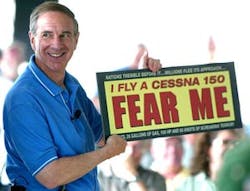AOPA Seeks Relaxed Flight Limits Around Nation's Capital
FREDERICK, Md. (AP) -- The nation's largest advocacy group for private pilots said Saturday it will ask the government to relax flight restrictions around the nation's capital.
The Aircraft Owners and Pilots Association wants the 30-mile restricted zone around the Washington Monument reduced to the roughly 15-mile radius that existed before the Sept. 11, 2001, terrorist attacks, AOPA President Phil Boyer said.
At a minimum, most small, single-engine airplanes should be exempt from requirements to file flight plans and obtain special identification codes before penetrating the outer ring of the restricted airspace, the group said.
Boyer, speaking to hundreds of pilots at an annual fly-in, said the Frederick-based group will submit its proposals to the Federal Aviation Administration as the FAA moves toward making permanent the temporary restrictions it implemented in 2003.
Boyer said the changes proposed by the 405,000-member group would reduce the number of violations _ more than 1,700 since 2003 _ and improve air safety by freeing pilots and air-traffic controllers from needlessly burdensome regulations.
''Let's balance ... the various threat and risk levels and mitigate, or set up mitigation techniques, based on what risks we're trying to avoid,'' Boyer said.
He said easing the restrictions also would help the operators of flight schools at airports within the restricted area whose sales have suffered since 2003.
Scott Proudfoot, an air safety investigator with the National Air Traffic Controllers Association, said the requirement for small planes to maintain constant, two-way communication with a controller while in the restricted zone has made the skies less safe by forcing each controller to talk with as many as 20 private pilots in addition to 10 to 15 commercial aircraft.
The fly-in was held at Frederick Municipal Airport, the same airport, 40 miles from Washington, where a pilot who had flown within three miles of the White House was forced to land May 11. Boyer and AOPA members said the single-engine, two-seat Cessna involved in that incident, typical of general aviation aircraft, was too small and fragile to be an effective terrorist weapon. The typical small aircraft weighs less than a Honda Civic and carries even less cargo, according to AOPA.
''If I wanted to do something destructive, my boat or my cars would be more effective,'' said William Kelley, 44, a pilot and software consultant from Chepachet, R.I.
Pilots at the event were divided on whether the government overreacted to the May 11 airspace incursion. But many said pilot Hayden L. Sheaffer, of Lititz, Pa., had given general aviation a black eye by allegedly failing to check the FAA's ''Notices to Airmen,'' which informs pilots of airspace restrictions.
The FAA revoked Sheaffer's license 12 days after the incident.
